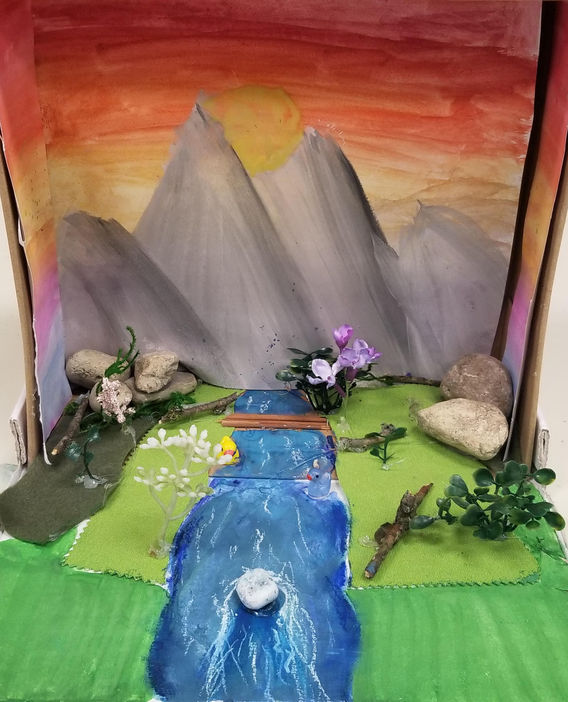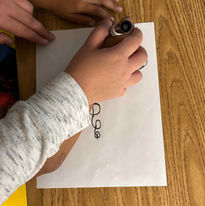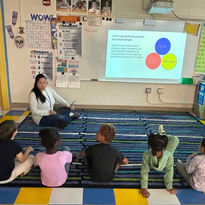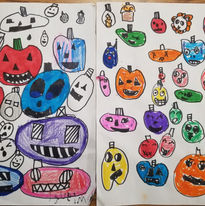Student Teaching
Self-created Unit Plans with Lesson Plans and Teaching Materials
IPTS (2013) STANDARD 2 - Content Area and Pedagogical Knowledge - The competent teacher has in-depth understanding of content area knowledge that includes central concepts, methods of inquiry, structures of disciplines, and content area literacy. The teacher creates meaningful learning experiences for each student based upon interactions among content area and pedagogical knowledge, and evidence-based practice.
IPTS (2013) STANDARD 5 - Instructional Delivery - The competent teacher differentiates instruction by using a variety of strategies that support critical and creative thinking, problem-solving, and continuous growth and learning. The teacher understands that the classroom is a dynamic environment requiring ongoing modification of instruction to enhance learning for each student.
Description: For this lesson, students must learn how to draw an anatomically correct face using vertical and horizontal guidelines for correct placement. After the students have been familiarized with the process, they designed their own original anime character and referenced a packet consisting of various styles of anime/manga facial features provided by me. Students were encouraged to experiment with different styles during the design process.
Rationale: Art is one of the many ways to combine interests/hobbies into one. Many students like anime and/or manga and some have shown interest in Japanese artists and culture. This lesson is culturally relevant to the current generation and allows students to expand their world view and explore distinct art styles.
Evidence: Refer to the link above
Description: In this lesson, students combined both 2D and 3D elements to create a diorama of a scene (e.g. a beach, living room during Christmas, parking lot, jungle, etc.). Students used found objects and recycled materials such as sticks, rocks, leaves, bottle caps, cardboard boxes, etc. to construct their diorama. Tools such as hot glue guns, utility knives, and wire cutters were provided for use along with some material such as tissue paper, fabric, and yarn. Students experimented with atmospheric perspective by creating an interesting 2D background and constructing 3D elements to add to the middle ground and foreground for an engaging narrative.
Rationale: Students had to use critical thinking skills and plan their process of constructing the diorama. "What will be the 2D background? What 3D elements can I add to the background? For the middle ground and foreground, what do I want the viewer to focus on?" These were questions that had to be answered as the diorama box needed to be constructed from back to front. "Do I have the materials that I need? Can I find it at home or outside? Can I make it? How do I make it? What do I need to make it?" This project encouraged students to problem solve and ruminate on their building process.
Evidence: Refer to the link above
Assessment Methods
IPTS (2013) STANDARD 7 - Assessment - The competent teacher understands and uses appropriate formative and summative assessments for determining student needs, monitoring student progress, measuring student growth, and evaluating student outcomes. The teacher makes decisions driven by data about curricular and instructional effectiveness and adjusts practices to meet the needs of each student.
Description: Before the introduction of the project, I implemented a pre-test to gauge the students' prior knowledge. The pre-test required students to draw a forward facing portrait that included 6 facial features (2 eyes, a nose, etc.). Questions such as "What is anime? What is manga?" were asked as an oral diagnostic assessment. After presenting, I implemented a step-by-step instruction in drawing an accurate forward facing portrait using vertical and horizontal guidelines. During instruction, I had 1 on 1 conferencing with each student to check for understanding. During line up (closure), students were quizzed with questions such as "Draw me a horizontal line with your finger. Where are the eyes placed? Where does the top of the ears start?". On the second day, students participated in a whole class review. After the review, students designed their own original anime/manga character using what they had learned and the anime/manga packet as reference (post-test).
Rationale: I utilize various forms of assessment to keep the students engaged and to check for understanding. I include diagnostic assessments to gauge students' prior knowledge and to analyze their skill levels. I implemented a pre-test and a post-test to examine student growth. I incorporate regular check ins and 1 on 1 conferencing throughout my lesson to provide specific instruction as each student has different areas of improvement.
Evidence: Refer to the link above
Description: During the introduction of the project, I asked questions such as "What is a diorama? What is atmospheric perspective?" I also asked multiple questions such as "What is the mood do you get from this diorama? How did the artist incorporate their culture into this art piece?" to provoke critical thinking. After the introduction, students were given a tree map to explore and map out their ideas. Students were then given a box template to organize their background, middle ground, and foreground. At the beginning of each studio day, I wrote questions such as "What will be 2D and what will be 3D? Do I have the materials that I need? Can I make it? How do I make it? What materials can I use to make it?" to promote critical thinking and problem solving skills. During the construction process, I checked in with every student and provided suggestions. Before clean up, I would ask students to raise their hand if they were half-way or mostly finished to gauge student progress. After the completion of the diorama, students wrote an artist statement and a short reflection using vocabulary words. We also had a whole class critique where students provided compliments and suggestions while viewing each other's artworks.
Rationale: I include multiple forms of assessment to ensure student comprehension and engagement. I incorporate starting questions such as "What is a diorama?" as a diagnostic assessment. Tree maps and theme box sketch served as a way for students to organize and plan their ideas, materials, and tools. I often checked in on students and engaged in 1 on 1 conferencing to keep tabs on student progress and to check for understanding. The artist statement required students to describe their artwork and artistic choices using vocabulary words. The reflection allowed students to analyze their strengths, what they found challenging, likes, and dislikes.
Evidence: Refer to the link above
Professionalism, Advocacy, and Leadership: PAL 1
IPTS (2013) STANDARD 9 - Professionalism, Leadership, and Advocacy - The competent teacher is an ethical and reflective practitioner who exhibits professionalism, provides leadership in the learning community; and advocates for students, parents or guardians, and the profession.




Description: I participated in Back to School Night where parents attended with their child/children. Teachers of various subjects such as P.E., STEM, music, and art presented a short introduction about their class. The teachers included broad topics that would be covered during the course, what materials to bring, and the expectations. My cooperating teacher, Adam Crane, introduced me to the parents and students during his presentation. Afterwards, I spoke with a few parents about what I would be teaching their children during my placement.
Rationale: It is commonly required for teachers to attend Back to School Night as it is an opportunity for parents to meet their child's teacher. Parents are also able to receive an outline of what their child will be learning. Back to School Night allowed me to experience conversing with parents as it is a requirement for a teacher to communicate with parents/guardians.
Evidence: Refer to photos
Professionalism, Advocacy, and Leadership: PAL 2
IPTS (2013) STANDARD 9 - Professionalism, Leadership, and Advocacy - The competent teacher is an ethical and reflective practitioner who exhibits professionalism, provides leadership in the learning community; and advocates for students, parents or guardians, and the profession.




Description: During my middle school placement, I taught 2 sessions of Art Club. For the first session, I introduced a browser game called Skribbl.io as an ice breaker activity. I also laid out paper and markers for students who wanted to free draw. During the session, I also taught 2-point perspective to students who wanted to learn how to draw a 2-point perspective house. For the second session, I taught students how to use tempera cakes to create a watercolour look. Students mixed warm and cool colours on each side of a circle that they drew with a plate. Students then painted a tree in the middle with bare branches stretching across the circle.
Rationale: Art Club is not a class, but a place for artistic students to create and learn about art at their leisure. Art teachers are not required to run an after/before school club; however, this experience has allowed me to introduce activities that don't necessarily belong in the classroom and build rapport with students that do not have art such as band students.
Evidence: Refer to photos





















































